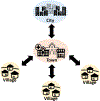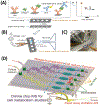Clinical Chemistry for Developing Countries: Mass Spectrometry
- PMID: 33979544
- PMCID: PMC8932337
- DOI: 10.1146/annurev-anchem-091520-085936
Clinical Chemistry for Developing Countries: Mass Spectrometry
Abstract
Early disease diagnosis is necessary to enable timely interventions. Implementation of this vital task in the developing world is challenging owing to limited resources. Diagnostic approaches developed for resource-limited settings have often involved colorimetric tests (based on immunoassays) due to their low cost. Unfortunately, the performance/sensitivity of such simplistic tests are often limited and significantly hinder opportunities for early disease detection. A new criterion for selecting diagnostic tests in low- and middle-income countries is proposed here that is based on performance-to-cost ratio. For example, modern mass spectrometry (MS) now involves analysis of the native sample in the open laboratory environment, enabling applications in many fields, including clinical research, forensic science, environmental analysis, and agriculture. In this critical review, we summarize recent developments in chemistry that enable MS to be applied effectively in developing countries. In particular, we argue that closed automated analytical systems may not offer the analytical flexibility needed in resource-limited settings. Alternative strategies proposed here have potential to be widely accepted in low- and middle-income countries through the utilization of the open-source ambient MS platform that enables microsampling techniques such as dried blood spot to be coupled with miniature mass spectrometers in a centralized analytical platform. Consequently, costs associated with sample handling and maintenance can be reduced by >50% of the total ownership cost, permitting analytical measurements to be operated at high performance-to-cost ratios in the developing world.
Keywords: centralized detection; disease diagnosis; microfluidic paper-based devices; microsampling; open analytical systems; point-of-care; portable analytical systems.
Figures








Similar articles
-
Automated Immunoassay Performed on a 3D Microfluidic Paper-Based Device for Malaria Detection by Ambient Mass Spectrometry.Anal Chem. 2022 Mar 29;94(12):5132-5139. doi: 10.1021/acs.analchem.1c05530. Epub 2022 Mar 16. Anal Chem. 2022. PMID: 35293204 Free PMC article.
-
Low-tech vs. high-tech approaches in μPADs as a result of contrasting needs and capabilities of developed and developing countries focusing on diagnostics and point-of-care testing.Talanta. 2024 Jan 1;266(Pt 1):124911. doi: 10.1016/j.talanta.2023.124911. Epub 2023 Jul 6. Talanta. 2024. PMID: 37536103 Review.
-
Nanomaterial-enhanced ambient ionization for miniature mass spectrometry: toward high-performance on-site detection.Mikrochim Acta. 2025 Jun 2;192(6):392. doi: 10.1007/s00604-025-07238-2. Mikrochim Acta. 2025. PMID: 40455291 Review.
-
Ambient Ionization Mass Spectrometry for Point-of-Care Diagnostics and Other Clinical Measurements.Clin Chem. 2016 Jan;62(1):99-110. doi: 10.1373/clinchem.2014.237164. Epub 2015 Oct 14. Clin Chem. 2016. PMID: 26467505 Free PMC article. Review.
-
The application of fully automated dried blood spot analysis for liquid chromatography-tandem mass spectrometry using the CAMAG DBS-MS 500 autosampler.Clin Biochem. 2020 Aug;82:33-39. doi: 10.1016/j.clinbiochem.2020.02.007. Epub 2020 Feb 19. Clin Biochem. 2020. PMID: 32087137 Review.
Cited by
-
Mass spectrometry for metabolomics analysis: Applications in neonatal and cancer screening.Mass Spectrom Rev. 2024 Jul-Aug;43(4):683-712. doi: 10.1002/mas.21826. Epub 2022 Dec 16. Mass Spectrom Rev. 2024. PMID: 36524560 Free PMC article. Review.
-
Rapid and Accurate Identification of Microorganisms Using Ion Mobility-Mass Spectrometry.Int J Mass Spectrom. 2025 Apr;510:117421. doi: 10.1016/j.ijms.2025.117421. Epub 2025 Feb 15. Int J Mass Spectrom. 2025. PMID: 40027846
-
Development of shotgun metabolomic profile analysis for detecting canine visceral leishmaniasis using flow-through pinhole paper spray mass spectrometry.Analyst. 2025 Jul 21;150(15):3457-3464. doi: 10.1039/d5an00451a. Analyst. 2025. PMID: 40590608 Free PMC article.
-
Diagnosis On-Demand: Field Evaluation of Microfluidic Paper Device for the Detection of Asymptomatic Malaria.Anal Chem. 2025 Jun 10;97(22):11787-11797. doi: 10.1021/acs.analchem.5c01324. Epub 2025 May 11. Anal Chem. 2025. PMID: 40350582 Free PMC article.
-
Automated Immunoassay Performed on a 3D Microfluidic Paper-Based Device for Malaria Detection by Ambient Mass Spectrometry.Anal Chem. 2022 Mar 29;94(12):5132-5139. doi: 10.1021/acs.analchem.1c05530. Epub 2022 Mar 16. Anal Chem. 2022. PMID: 35293204 Free PMC article.
References
-
- Goltz MN, Kim D, Racz LA. 2011. Using Nanotechnology to Detect Nerve Agents. Air & Space Power Journal, 25(2): 56–60.
-
- Leary PE, Kammrath BW, Lattman KJ, Beals GL 2019. Deploying Portable Gas Chromatography–Mass Spectrometry (GC-MS) to Military Users for the Identification of Toxic Chemical Agents in Theater Applied Spectroscopy 73 (8): 841–858. - PubMed
-
- The Economist. 2000. Hopeless Africa https://www.economist.com/leaders/2000/05/11/hopeless-africa
Publication types
MeSH terms
Grants and funding
LinkOut - more resources
Full Text Sources
Other Literature Sources

